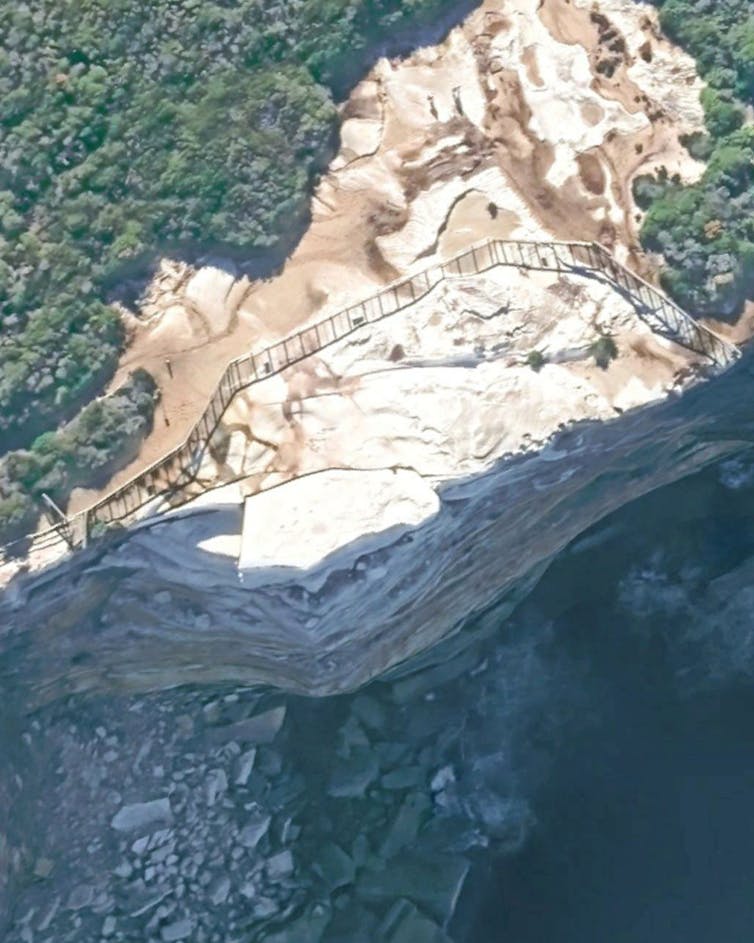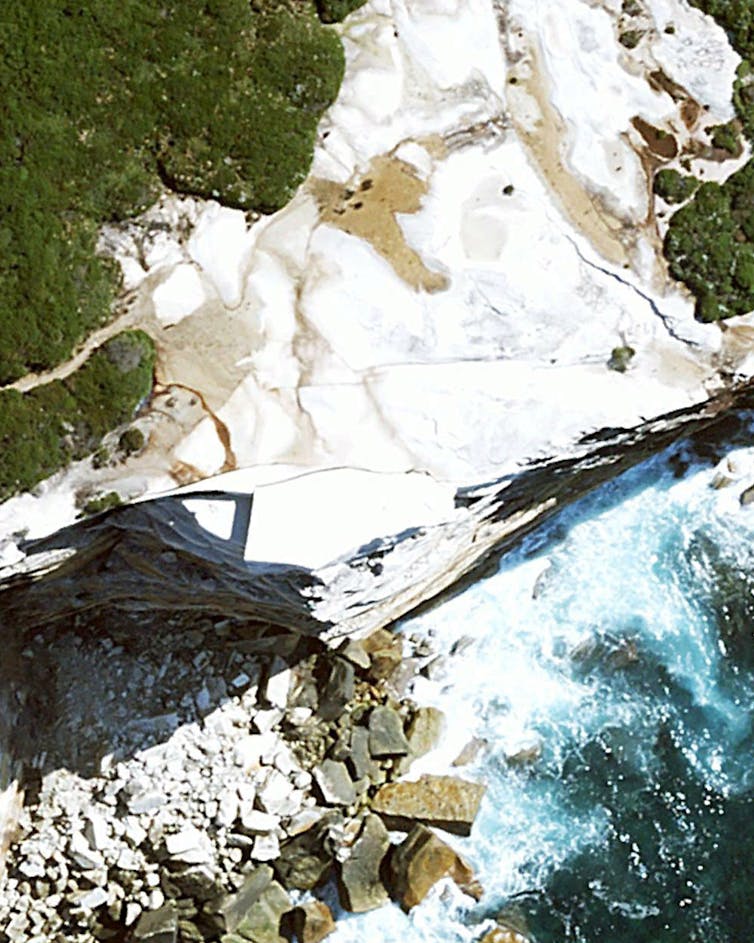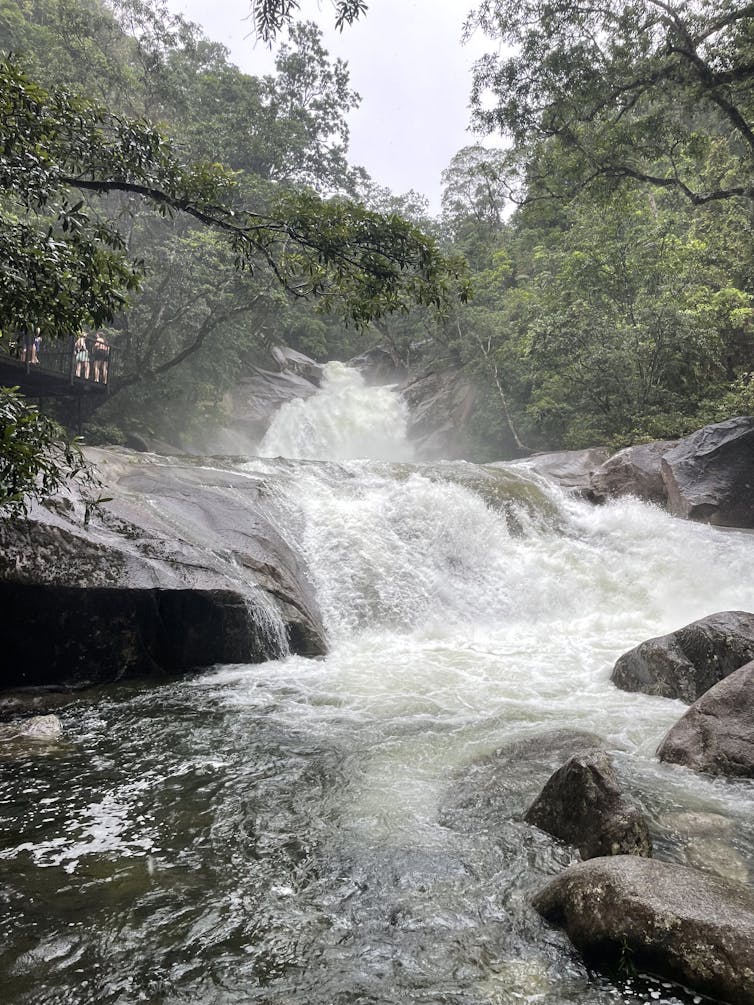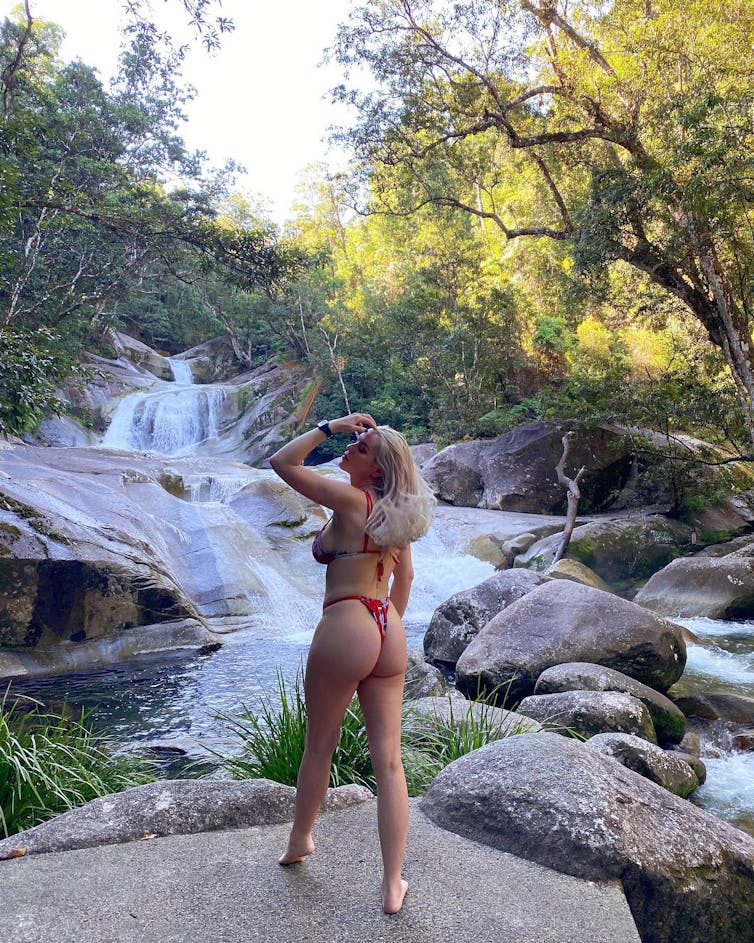In a lush valley west of Cairns, Freshwater Creek flows over the Crystal Cascades.
Thousands of visitors flock to the clear pools dotted along the rocks.
It's the perfect place for a photo.

In a lush valley west of Cairns, Freshwater Creek flows over the Crystal Cascades.
Thousands of visitors flock to the clear pools dotted along the rocks.
It's the perfect place for a photo.

Open Instagram and you'll find hundreds of videos and images of people swimming, diving and exploring the falls. Tags like #ChasingWaterfalls and #HotGirlSummer hype the content.
This video of a man jumping from the cliff has been viewed 358,000 times.
But as beautiful as it is, this place is deadly. A young man drowned in 2014, a father and son in 2023 and a tourist in 2024.
It’s a story repeated at scenic spots across Australia, where the pursuit of the perfect selfie too often ends in tragedy.
The Instagram effect: dying for the perfect photo
Social media tourism is encouraging risky behaviour and the death toll is mounting.
By Sam Cornell & The Conversation Digital Storytelling Team
It's incredible the extreme lengths some people will go to in search of the perfect photo.
Would you risk climbing this spike mounted fence at the Colosseum?
One tourist thought it was a good idea until he fell and pierced his spine, dangling until paramedics could remove him.
Photo: Wanted In Rome, Nikolpetr/Shutterstock
Photo: Wanted In Rome, Nikolpetr/Shutterstock
Another fell into an active volcano in Italy.
But they're the lucky ones who survived.
379 people died taking selfies between 2008 and 2021.
I've been studying social media deaths for the past three years and I estimate we've now passed 500 deaths.
Annual global social media-related deaths
People are risking their lives at cliff edges, mountain overhangs and around water.
My systematic review of selfie-related incidents found falls from height and drowning were the most common ways to die.
While men make up most drowning deaths overall, women are disproportionately represented in social-media-driven cliff and waterfall incidents because they post more “high-risk” imagery.
Social media tourism
This is Wedding Cake Rock in Sydney's Royal National Park.


Source: 2014 and 2023, Google Earth .
Satellite images show where fencing was installed in 2016, but visitors still jump over.
Photo: Instagram
Photo: Instagram
Social media now drives a measurable share of national park visits.
In NSW, 32% of adults reported visiting a coastal park because they saw it online, led by Instagram and TikTok for younger users.
In a recent national survey of Australian social media users, 9.4% said they had taken risks outdoors specifically to create content.
Of those who went because of social media, 65% said they went to get photos, and 36% took photos in risky locations like cliff edges or beyond barriers.
Risk-taking was concentrated in younger adults and heavy social-media users, which matches what land managers are seeing on the ground.
Self-defined influencers are 20 times more likely to engage in risky behaviour.
"We started seeing people in high heels"
On a bright spring afternoon in 2023, a 22-year-old tourist visited Cape Woolamai on Victoria’s Phillip Island. As she edged closer to the cliff for a photo, she slipped, falling 50 metres.
She suffered serious injuries before being winched out by helicopter and rushed to hospital.
The cliff at Cape Woolamai. Photo: Neil O'Shaughnessy/ABC
The cliff at Cape Woolamai. Photo: Neil O'Shaughnessy/ABC
At Paradise Caves in Noosa, paramedics recently staged a rope rescue after a woman slipped down a cliff face.
A US tourist fell onto rocks from a cliff at Paradise Caves on the Sunshine Coast. Photo: RACQ LifeFlight
A US tourist fell onto rocks from a cliff at Paradise Caves on the Sunshine Coast. Photo: RACQ LifeFlight
At Bushrangers Bay in Victoria, a 24-year-old man died falling from rocks in early 2023.
Cape Schanck near the Two Bays walking track at Bushrangers Bay when the man fell. Photo: Visit Mornington Peninsula
Cape Schanck near the Two Bays walking track at Bushrangers Bay when the man fell. Photo: Visit Mornington Peninsula
Many visitors to Australia's hotspots can be described as “new tourists”, drawn less by nature than by the chance to recreate the shots they’ve seen online.
Social media algorithms drive audiences to spectacular cliff-edge or waterfall poses, fuelling a cycle of imitation.
In my interviews with Australian land managers, many described being blindsided by this burgeoning class of sightseer.
A Queensland park ranger spoke of visitors turning up unprepared:
“We started seeing people in high heels. People bringing their cats in a backpack for a quick visit. Not bushwalkers. A new kind of visitor."
As one manager put it:
“All it would take would be one well-known influencer getting a selfie and all of a sudden you have a lot more people out there.”
One influencer who I interviewed told me:
"... if you're a company that's organising a tour and you know that there's risk, I think you need to disclose that, disclose who is recommended on this, who is not. But I don't think it's a content creator's responsibility to do that. They're just there to entertain."
Others admitted breaching barriers for a shot, saying,
“I assess the risk myself.”
Josephine Falls has a number of large warning signs and barriers. Photo: author supplied
Josephine Falls has a number of large warning signs and barriers. Photo: author supplied
Half the land managers surveyed didn’t even track selfie-related incidents, and most admitted legacy safety strategies like signs and fences were failing with this digital-native audience.


A typical social media photo from Josephine Falls in Queensland. However, the river can quickly become dangerous and a number of people have died there. Photo: Instagram, author supplied.
The wider impact
Each incident ripples outward.
Emergency services spend thousands of dollars and hours on helicopter winch and technical rope rescues.
Local councils face lawsuits, reputational damage, and angry debates over whether they should restrict access to iconic lookouts.
Communities watch as sacred or environmentally fragile sites are trampled for content.
For survivors, the consequences last far longer than a post in their feed.
Serious injuries can result in significant recovery times, or even lifelong disability.
What can we do?
Research suggests safety messages must meet people where they are: on their phones. That means short, visual, shareable warnings designed for Instagram and TikTok, not just signs in the bush.
This mock-up was part of a proposed in-app safety warning submitted to Meta as part of a funded project. Ultimately Meta didn't proceed with the implementation. Image: Amy Peden, William Koon, Rob Brander
This mock-up was part of a proposed in-app safety warning submitted to Meta as part of a funded project. Ultimately Meta didn't proceed with the implementation. Image: Amy Peden, William Koon, Rob Brander
Councils and tourism bodies can trial geotag “nudges,” discouraging posts that reveal the exact coordinates of fragile or dangerous spots.
Influencer partnerships could flip the script – showcasing safer photo alternatives or using their reach to highlight risks.
Influencers told me they will share safety if it feels authentic – for example, weaving a slippery track into the story – but not if it reads like a brochure.
Crucially we need social media companies to do more; we need more regulation.
Age restrictions for children show when there's the will, social media companies can be compelled to enact safety measures.
|
What exists |
What’s missing |
|---|---|
|
Physical signs with text |
In-app safety warnings |
|
Fences/barriers |
Platform accountability / algorithm nudges |
|
Ad hoc site closures |
Coordinated strategy across agencies |
|
Occasional fines |
Prevention campaigns tailored for digital audiences |
Importantly, the issue is still not recognised as a distinct public-health problem, like drowning or road safety.
Without that framing, there’s little resourcing for prevention campaigns, data collection, or cross-jurisdictional coordination.
As one land manager said, “You can put up a fence or a sign, but if someone wants that photo, they’ll find a way around it.”
If we want to keep Australia’s most photogenic places open and safe, we’ll need to meet social media’s pull with strategies just as persuasive.
Acknowledgements
Thank you to the Queensland Parks and Wildlife Service and Adell Ranger for their support with this article.
Authors
PhD Candidate in Public Health & Community Medicine, School of Population Health, UNSW Sydney
Editorial production
Development and design
Editorial Web Developer
Digital Storytelling Editor
Disclosures
Samuel Cornell receives funding from Meta Platforms, Inc. His research is supported by a University of New South Wales Sydney, University Postgraduate Award. His research is supported by Royal Life Saving Society – Australia to aid in the prevention of drowning. Research at Royal Life Saving Society – Australia is supported by the Australian government. He has been affiliated with Surf Life Saving Australia and Surf Life Saving NSW in a paid and voluntary capacity.








